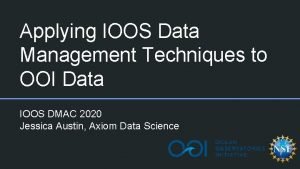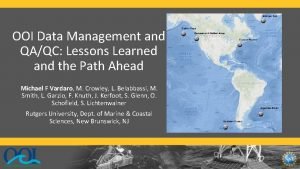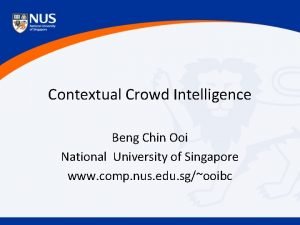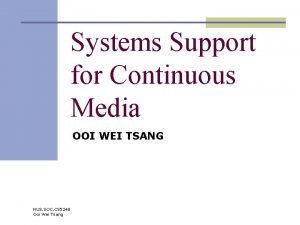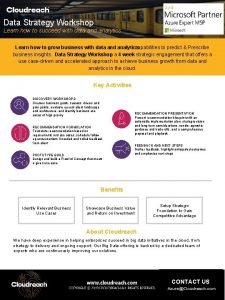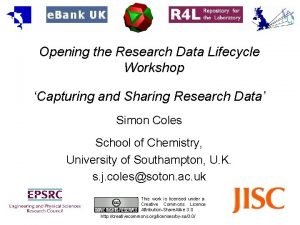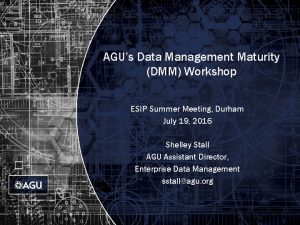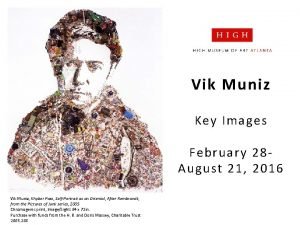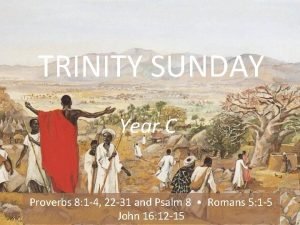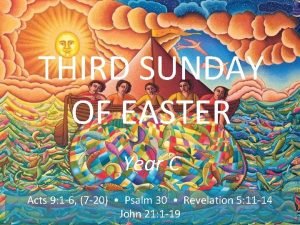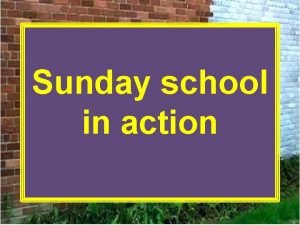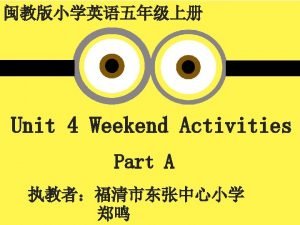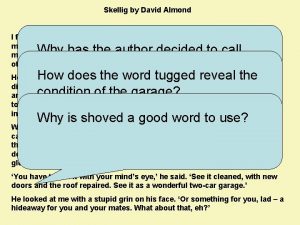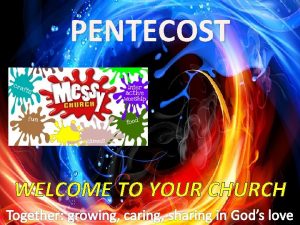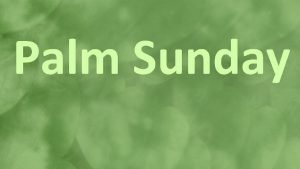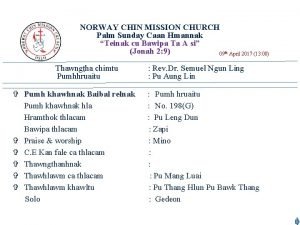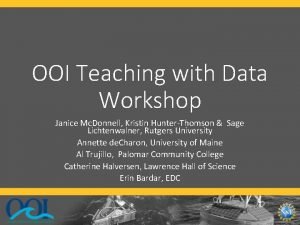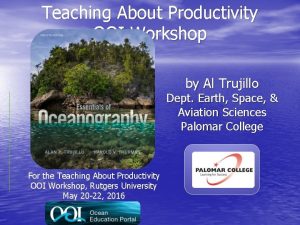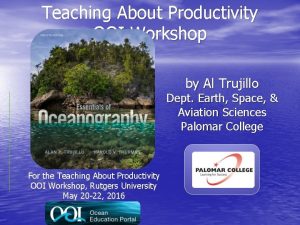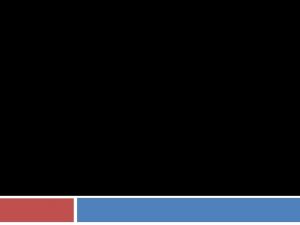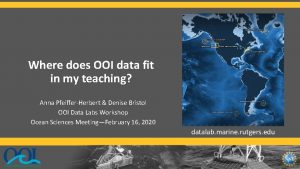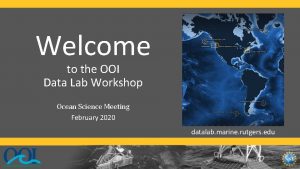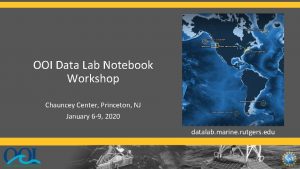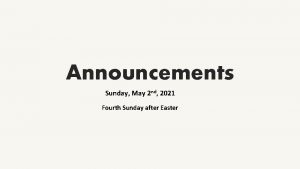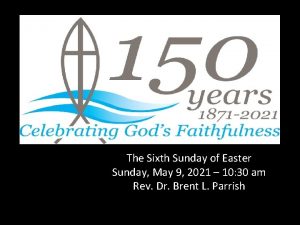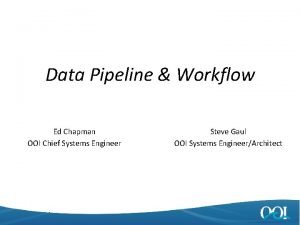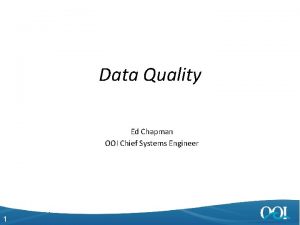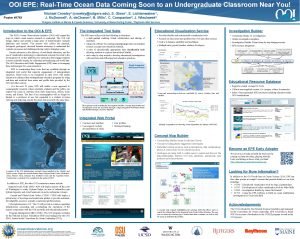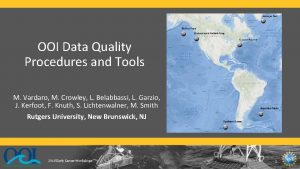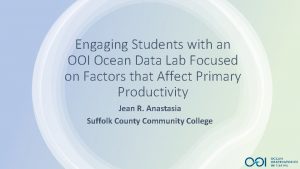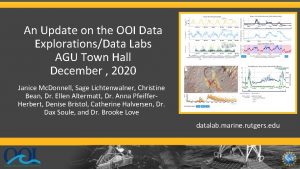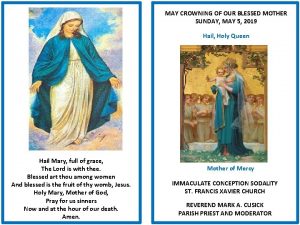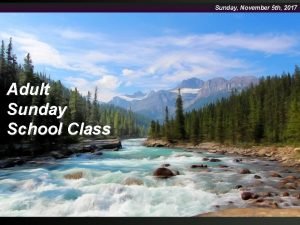OOI Teaching with Data Workshop Sunday May 22





























- Slides: 29

OOI Teaching with Data Workshop Sunday May 22, 2016

Sunday: Welcome Back! • Review agenda for today • Time to pull this all together • Provide Revisions • Implementation plans • NSF proposal – next steps • Stipends processing

Workshop Objectives • Crosswalk OOI Science themes presented in popular introductory textbooks used in oceanography courses. Compare themes and concepts in the OOI scientific themes document and popular published textbooks to triangulate where OOI data investigations/activities can be woven into existing courses. • Develop sample activities using OOI data/data viz tools and vet them with undergraduate professors. • Brainstorm how best to build a community of practice. Build long-term working relationships and collaborations on data investigation development.

Exploring Primary Productivity with Data & Design Elements Invitation Concept Map Reflection Concept Map Application Data Activity Exploration Data Activity Concept Invention Data Activity 1 Concept Invention Data Activity 2

Exploring Primary Productivity with Data & Design Elements • One data set is locked, user only needs to select another to compare data sets Concept Map • List of. Invitation data is prepopulated • The user can adjust the Reflection Concept Map time frame, and the scale bar automatically adjusts • The data easily plot onto the same graph, no need to look between graphs Application Data Activity Exploration Data Activity Concept Invention Data Activity 1 Concept Invention Data Activity 2

Exploring Primary Productivity with Data & Design Elements • Two data sets are provided to help user make observations across. Invitation multiple. Concept locations Map • Able to only look at one location at a time Exploration Data Activity Reflection Concept Map • Same set-up of graph and variable that was looked at previously to minimize orientation needed Application Data Activity Concept Invention Data Activity 1 Concept Invention Data Activity 2

Exploring Primary Productivity with Data & Design Elements Reflection Concept Map Application Data Activity • Multiple data sets provided, but user has to Invitation Concept Map make decision of what to turn on and off for analysis. Exploration Data Activity • List of data is prepopulated • User has to look more among graphs to do data analysis Concept Invention Data Activity 1 Concept Invention Data Activity 2

Modifying Data Activities

Revised Activity Presentation

Data-enhanced learning experiences. . including activities in which students collect and interpret their own data and/or those in which they explore research databases to answer questions. Data enhanced learning experiences can: • Prepare students to address real-world complex problems; • Develop students’ ability to use scientific methods, including consideration of the values and ethics of working with data; • Teach students how to critically evaluate the integrity and robustness of data or evidence and of their consequent interpretations or conclusions; and • Provide training in scientific, technical, quantitative, and communication skills. Manduca and Mogk 2002. Using Data in Undergraduate Science Classrooms (Grant NSF-0127298) 10

Design of data activities Questions to ask about the goals of the activity Invitation How does it get students interested in learning about the topic? How does it help them access their prior knowledge? Exploratio n How will learners have experiences that provide concrete observations and discoveries to help them make sense of the topic? Concept Invention How will learners be encouraged to struggle with their understanding and negotiate their ideas with others? Applicatio n How will learners authentically apply what they've learned to a new situation or context? Reflection How will learners think back on the learning process to help reinforce their understandings, and make them better learners in the future? Name of Data Activity – what did we do? Which phase does it match up with? How does it accomplish the goals of that phase?

Design of data activities Questions to ask about the activity Name of Data Activity – what did we do? Which phase does it match up with? How does it accomplish the goals of that phase? Invitation How does it access students prior knowledge and get them interested in learning about the topic? Create a concept map of primary productivity to access and connect to prior knowledge. Exploratio n How will learners have experiences that provide concrete observations and discoveries to help them make sense of the topic? Data figures of measurements of primary productivity. User changes time & four variables to make general observations & ask questions to try to make sense of the patterns. Concept Invention How will learners be encouraged to struggle with their understanding & negotiate their ideas with others? Data figures of primary productivity at different latitudes (2 activities). Users are given two data sets to observe & are challenged to interpret patterns w/in a defined location & time (with other users). Applicatio n How will learners authentically Data figures of primary productivity from different apply what they've learned to a new regions. User provided choices & makes own situation or context? determination about how to explore the data to understand differences in primary productivity. Reflection How will learners think back on the learning process to help reinforce their understandings, and make them better learners in the future? Revise original concept map of primary productivity. Compare how ideas have changed and discuss what helped to deepen their understanding of how to teach/connect primary productivity concepts/topics.

Where do we integrate data in teaching? Course Syllabus Lecture Online 13 Active Learning

NSF IUSE The Improving Undergraduate STEM Education (IUSE: EHR) program invites proposals that address immediate challenges and opportunities that are facing undergraduate STEM education, as well as those that anticipate new structures (e. g. organizational changes, new methods for certification or credentialing, course re-conception, cyberlearning, etc. ) and new functions of the undergraduate learning and teaching enterprise.

Goals • Improve STEM Learning & Learning Environments: Improve the knowledge base for defining, identifying, and innovating effective undergraduate STEM education teaching and learning for all NSFsupported disciplines, and foster widespread use of evidencebased resources and pedagogies in undergraduate STEM education. • Broaden Participation & Institutional Capacity for STEM Learning: Increase the number and diversity of undergraduate students recruited and retained in STEM education and career pathways through improving the evidence base for successful strategies to broaden participation and implementation of the results of this research. • Build the Professional STEM Workforce for Tomorrow: Improve the preparation of undergraduate students so they can succeed as productive members of the future STEM workforce, regardless of career path, and be engaged as members o

IUSE Tracks • Engaged Student Learning: proposals should clearly describe the steps they will take to design, develop, and implement promising teaching approaches, tools, resources, or models. • Institutional and Community Transformation: Exploration and Design projects should include a description of the participant team, the target audience, the institution(s) or community to be transformed and the actions to be taken to move toward broader implementation.

Applying for an IUSE grant: • Option #1: Data and Activity Development Center • Option #2: Design and Development of Desktop Version

What they are looking for: • projects that use innovative approaches to increase substantially the widespread use highly effective, evidence-based STEM teaching and learning, curricular, and co-curricular practices in institutions of higher education or across/within disciplinary communities.

NSF IUSE • Full Proposal Deadline Date: November 2, 2016 Exploration and Design Tier for Engaged Student Learning & Institution and Community Transformation • Full Proposal Deadline Date: January 11, 2017 Development and Implementation Tiers for Engaged Student Learning & Institution and Community Transformation

Incorporation planning Choose which data activities AND learning aspects from this weekend to implement next year: • Why? • How? • What take out?

Questions for You: • What phase(s) of the learning cycle can the activity(ies) address in your classroom? In what ways? • How will you incorporate learning science research (Foundational Ideas of Learning) in your classroom? • What supports will you provide for your students?

Evaluating our Success In Implementation: • Develop sample activities using OOI data/data viz tools and vet them with success with students. • Brainstorm how best to build a community of practice.






Questions for Professors • What were you expecting from the activities when you signed up? • What do you feel the activities offered? • How was what the activities offered different from what you were expecting?

Thank you! 29 We are excited and grateful for your partnership
 Ooi data access
Ooi data access Ooi data access
Ooi data access Sunday bloody sunday guitar lesson
Sunday bloody sunday guitar lesson Sunday school lessons first sunday after easter
Sunday school lessons first sunday after easter Regisseur vroulike vorm
Regisseur vroulike vorm Ooi beng chin
Ooi beng chin Ooi wei tsang
Ooi wei tsang Ooi phaik yee
Ooi phaik yee Comparison between micro teaching and traditional teaching
Comparison between micro teaching and traditional teaching Hci patterns may or may not include code for implementation
Hci patterns may or may not include code for implementation Data strategy workshop
Data strategy workshop Data capturing workshop
Data capturing workshop Data maturity workshop
Data maturity workshop Sunday morning worship service
Sunday morning worship service Sugar children: valicia bathes in sunday clothes
Sugar children: valicia bathes in sunday clothes What did you do last summer
What did you do last summer Trinity sunday year c
Trinity sunday year c Third sunday of easter year c
Third sunday of easter year c Sunday night prayer
Sunday night prayer Sunday evening prayers
Sunday evening prayers Sunday action
Sunday action Activities on saturday
Activities on saturday Morning church service
Morning church service I found him in the garage on a sunday afternoon
I found him in the garage on a sunday afternoon Sixth sunday of easter year c
Sixth sunday of easter year c 2nd sunday of easter year c
2nd sunday of easter year c Romeo and juliet timeline day by day
Romeo and juliet timeline day by day Pentecost sunday crafts
Pentecost sunday crafts Palm sunday around the world
Palm sunday around the world Palm sunday hla
Palm sunday hla
